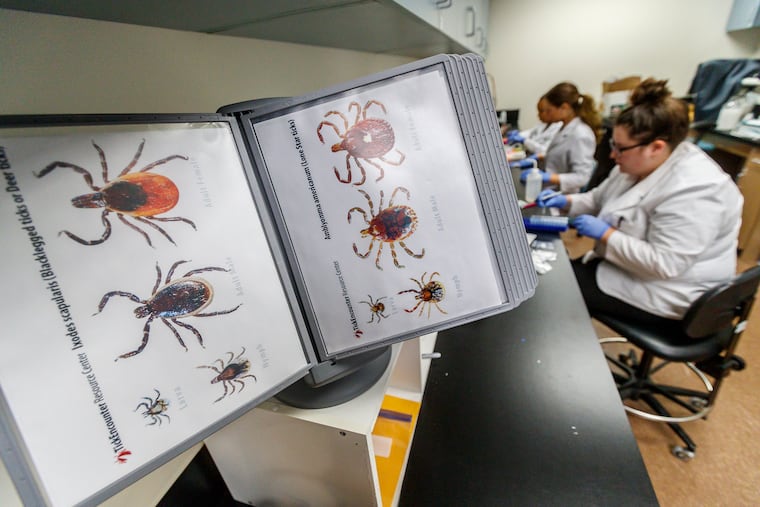Find a tick on your body? In Pa., you can get it tested — for free.
Pennsylvania has had the highest number of Lyme disease cases in the U.S. since 2000, with 7,457 in 2014 alone.

EAST STROUDSBURG, Pa. — Each day, an office building by the Delaware River in the Poconos is inundated with blood-sucking ticks, plucked from people and their pets, double-wrapped in plastic, and shipped first-class from all over Pennsylvania.
Ticks come into the Pennsylvania Tick Research Lab at East Stroudsburg University from other states, too, even other countries, and the people who send them wait, sometimes nervously, for answers. On Monday alone, 300 ticks arrived, and all of them would be crushed up by lab technicians so that their DNA could be examined and the results sent back to their hosts.
“Within three business days, you’ll get results as to what type of things the tick was carrying,” said lab director Nicole Chinnici. “That’s typically before symptoms are occurring, so you can take those results to your physician or your veterinarian to help them determine what they should be looking out for. It gives them a peace of mind when it comes back negative."
The bad news, Chinnici said, is that more than 50 percent of the ticks tested at the lab are carrying some type of disease.
Most of the ticks that come into the lab are dead, but some aren’t. Ticks are hard to squish. Sometimes people send in critters that aren’t even close to being a tick, though.
“Beetles, spiders, sometimes lice, bedbugs, various other things, even scabs," Chinnici said.
Lyme disease is the most common disease the ESU lab is finding in its ticks. Anaplasmosis, which causes flulike symptoms in early stages, is second. The lab finds ticks carrying babesiosis, which also causes flulike symptoms, along with Powassan virus, which can lead to encephalitis, altered mental status, and seizures. In New Jersey, a man who was bitten by a tick while gardening and later died tested positive for Powassan.
According to the Centers for Disease Control and Prevention, Pennsylvania has had the highest number of Lyme disease cases in the United States since 2000. The CDC found there were 7,457 reported cases in 2014. A recently released tick survey conducted by Muhlenberg College found the rate of Lyme disease in Lehigh County at 80 cases per 100,000 residents. The team collected 6,398 ticks during a four-year period and noted that 20 percent of black-legged tick nymphs, “the villains when it comes to spreading diseases,” carried the bacteria that cause Lyme disease.
Ticks often contract the diseases from mice and pass them along to humans. The longer they are attached to a human, the more likely the chance of contracting the diseases they carry. Deer, a common host for ticks, fight off the diseases. Many dogs, Chinnici said, are not affected by Lyme disease.
Even if you already have Lyme disease, you can still get new strains of the disease through another tick bite.
“There’s too many different strains of Lyme disease,” she said.
Chinnici said the lab has seen a large increase in the number of ticks being shipped over — 5,000 since April — thanks in part to $500,000 it received from the Pennsylvania Department of Health and Human Services that allows it to test ticks for Pennsylvania residents, free of charge. For out-of-state residents, the testing can range from $50 to $200. The lab has been operating since 2005.
Drexel University also operates a lab that’s researching which ticks carry certain diseases. That lab is no longer accepting specimens and does not conduct diagnostic testing for the public.
While much has been written about climate change and its role in tick populations, the Muhlenberg Survey found "no correlation between annual weather patterns and the number of ticks collected.” Chinnici said multiple factors are at play, including population booms and busts among hosts.
“Shorter winters allow them to survive longer," she said. "In addition to that, the seasons we have here in the Northeast, the humidity and rainfall, is very good for them.”
The lab, Chinnici noted, has had only one escape.
"We had one dog tick crawl out of a plastic bag and it was just sitting on the ledge, questing for a host,” she said.
Questing is what ticks do at the end of long blades of grass, holding their first pair of legs outstretched to latch onto a deer, dog, or hiker. It’s the tick version of hitchhiking, albeit with a bloodlust.
To combat the ticks, Chinnici simply checks herself as much as possible when in the woods. She doesn’t use any chemical sprays but is developing a top-secret, organic tick repellent she wasn’t quite ready to talk about it.
“Just always check, even when you don’t think you should,” she said. “We find the majority of people getting bit were just in [their] backyard.”
If you’ve been bitten by a tick in Pennsylvania and want to get it tested, you can find more information here.